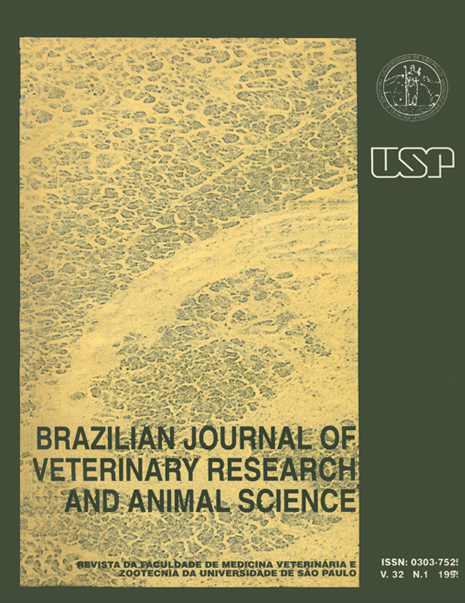Etiologic study of urinary tract infection in dogs
DOI:
https://doi.org/10.11606/issn.1678-4456.bjvras.1994.52087Keywords:
Dogs, Urinary tract infections, Cystitis, PyelonephritisAbstract
Urinary tract infections were documented in 51 dogs. Several factors such as etiologic agents, localization of the infection, predisposing factors, sex, age, and breed were considered. The diagnosis of urinary tract infection (UTI) was based on bacteriological investigation and it was considered positive when urine sample collected by catheterization contained more than 105 bacteria/ml. Mixed infection was found in 4 of the infected dogs, totallizing 55 isolates. Among them, Escherichia coli (35.3%) was the most frequently isolated, followed by Staphylococcus sp. (23.5%), Proteus mirabilis (15.7%), Streptococcus sp. (13.7%), Klebsiella sp. (9.8%). Pseudomonas aeruginosa (3.9%), Enterobacter cloacae (2.0%), Citrobacter freundii (2.0%) and Providencia rettgeri (2.0%). As to antimicrobial susceptibility, norfloxacin and gentamicin were successful for the treatment of gram-negative microorganisms, while the most effective drugs for gram-positive bacteria were cephalothin and nitrofurantoin. UTI was observed more frequently in Cocker Spaniel and German Shepherd; male dogs were more involved, and pyelonephritis was the predominant disease observed. Infection was seen in all ages, but the frequency was higher in middle aged dogs. Urolithiasis were observed as common predisposing or underlying factors to UTI being, cither Staphylococcus sp. or Proteus mirabilis isolated in those cases which alkaline urine pH was observed.
Downloads
Downloads
Published
Issue
Section
License
The journal content is authorized under the Creative Commons BY-NC-SA license (summary of the license: https://





